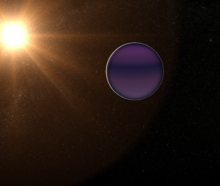HD 76700 b
 An artist's impression of HD 76700 b orbiting its host star. | |
| Discovery[1] | |
|---|---|
| Discovered by | Tinney, Butler, Marcy et al. |
| Discovery site | |
| Discovery date | July 5, 2002 |
| Radial velocity | |
| Orbital characteristics | |
| 0.0511 ± 0.0030 AU (7,640,000 ± 450,000 km)[2] | |
| Eccentricity | 0.10±0.08[3] |
| 3.97097±0.00023 d[3] | |
| 2451213.32±0.67 JD[2] | |
| 30°[2] | |
| Semi-amplitude | 27.6±1.7 |
| Star | HD 76700 |
| Physical characteristics | |
| 0.99 RJ | |
| Mass | 0.21±0.03 MJ[3] |
| 5.82 m/s2 | |
| Temperature | 1316+85 −252 K |
HD 76700 b is an exoplanet orbiting the G-type main sequence star HD 76700, approximately 198 light years away in the southern constellation Volans. The planet was discovered in 2002, and was announced in 2003.
Discovery
[edit]In 2002, a group of scientists detected planets around multiple stars, along with HD 76700. Unlike the other planets, HD 76700 b has a short and circular orbit; however, according to the newest data, the planet's orbit may be slightly eccentric.
Properties
[edit]Due to the planet's high mass, it is a gas giant similar to Saturn. HD 76700 b was detected indirectly, so properties such as its radius, inclination, and temperature is unknown. HD 76700 b has a short four day orbit around its host due to it being eight times closer than Mercury is to the Sun.
References
[edit]- ^ Tinney, C. G.; et al. (2003). "Four New Planets Orbiting Metal-enriched Stars". The Astrophysical Journal. 587 (1): 423–428. arXiv:astro-ph/0207128. Bibcode:2003ApJ...587..423T. doi:10.1086/368068. S2CID 10163020.
- ^ a b c Butler, R. P.; et al. (2006). "Catalog of Nearby Exoplanets". The Astrophysical Journal. 646 (1): 505–522. arXiv:astro-ph/0607493. Bibcode:2006ApJ...646..505B. doi:10.1086/504701. S2CID 119067572.
- ^ a b c Stassun, Keivan G.; Collins, Karen A.; Gaudi, B. Scott (1 March 2017). "Accurate Empirical Radii and Masses of Planets and Their Host Stars with Gaia Parallaxes". The Astronomical Journal. 153 (3): 136. arXiv:1609.04389. Bibcode:2017AJ....153..136S. doi:10.3847/1538-3881/aa5df3. ISSN 0004-6256. S2CID 119219062.
External links
[edit]- "HD 76700". Exoplanets. Archived from the original on 2009-11-25. Retrieved 2008-11-04.
- "HD 76700 b". Exoplanet Kyoto. Retrieved 2021-08-13.